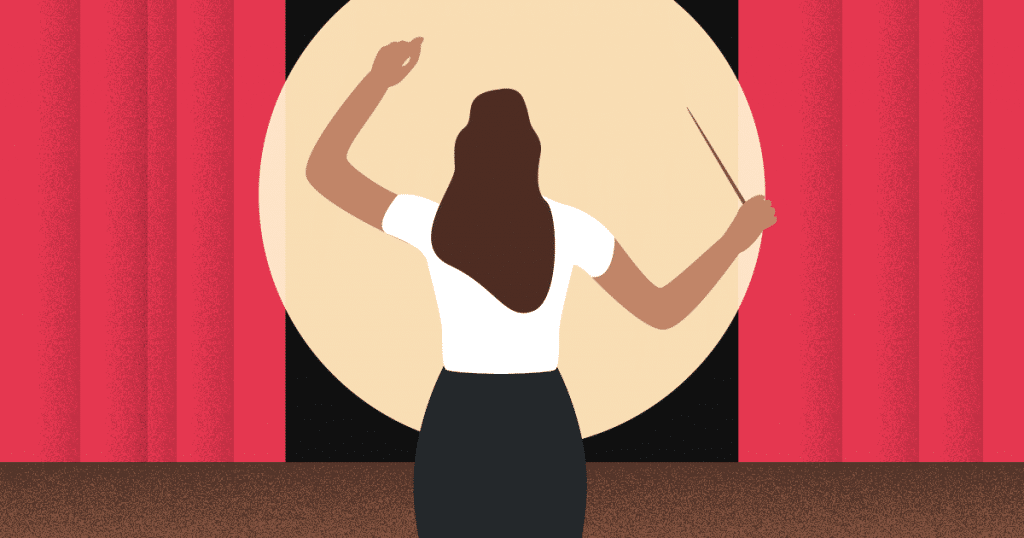Digital Marketing is an increasingly dynamic field of activity, involving different channels and various consumer interaction forms.
In a constantly changing scenario, new trends, social networks, and demands arise daily. This changes the various departments of a company once they must work aligned and organized.
It is like an orchestra. Even though each musician plays an instrument with a different sound, the outcome must be harmonious.
The conductor, gesturing in front of the musicians, organizes the team and produces a result that delights the audience. The idea behind marketing orchestration is something like that.
This term, relatively new in the commercial world, refers to a set of tactics that are already being used by several companies to generate better results. Interested? Keep reading to find out:
- What is marketing orchestration?
- What are the benefits of using this strategy?
- How does marketing orchestration work in practice?
What is marketing orchestration?
Marketing orchestration is a practice usually implemented in account-based marketing strategies since the idea is to focus on an already known prospect.
With access to information about their preferences, needs, and behavior patterns, it is easier to reach the consumer with the right message and take them further in the sales funnel.
However, this practice is not limited to launching personalized campaigns. More than that, it involves a series of cross-channel interactions.
When perceived in a general context, this provides the consumer with a unique and personalized experience, paving the way to conversion.
Such a series of interactions must be planned, taking into account the buyer persona’s characteristics and the company’s objectives.
After all, you can orchestrate actions to convert new customers, but you can also employ them to perform contract renewals and upsells.
Another relevant point in marketing orchestration is how you collect and utilize user data.
They are critical to accurately define your target and provide the information you need to produce a responsive, agile, efficient, and enjoyable user experience.
When placed in the context of data-oriented marketing, orchestration can also refer to the database organization. All data need to be centralized on one platform and well-segmented to be used efficiently.
Besides, they must be available to all departments that may need them.
In this scenario, it is important to have a team capable of understanding and analyzing the information. You must also provide the necessary tools to optimize the data visualization process.
What are the benefits of using this strategy?
The main benefit of using this strategy is enhancing the organization of your actions.
After all, marketing orchestration embraces activities previously defined, which interact with each other and contribute to a positive result. Thus, it is easier to develop and track different campaigns.
The use of multiple channels also allows you to collect user data with greater ease and abundance.
Imagine, for example, that you are conducting an email marketing campaign. In one of the messages, a link directs the person to your Instagram page. If the content is quality, you can earn another engaged follower.
Content production, of course, must also be orchestrated. It is essential to use efficient tools to produce, schedule, and publish materials in your different channels.
The objective is to maintain the posting frequency and preserve the relevance of your blog and social networks.
Thus, you can plan the perfect timing to launch your actions and delight the buyer persona.
All this synchrony among the departments responsible for collecting data, producing content for the different networks, making sales contacts, and taking care of consumer satisfaction culminates in customer loyalty.
That allows you to create loyal brand promoters. What does it mean? A powerful organic reach and a huge increase in brand awareness.
How does marketing orchestration work in practice?
You are already aware of marketing orchestration benefits and know that the term refers to a series of interactions that contribute to the same end.
However, how does that happen in practice? Well, a strategy with this approach works in a system of “plays”, each one representing a series of actions aimed at achieving a business goal.
When orchestrating the plays, you can guide yourself according to 5 categories:
- intent and engagement;
- MQAs;
- shake the tree;
- closed won;
- closed lost.
It is important to stress that all plays can involve both automated and manual elements. Next, we will talk about how each of the above categories works.
Intent and engagement play
When someone interacts with your content, they demonstrate the intent to establish some kind of relationship with your brand.
Then, it’s up to you to orchestrate the necessary process to transform this engagement into conversion.
From a multi-channel orchestrated play, you can influence the lead’s decision and direct them to the next stage of the funnel.
Below, check out an image taken from an Engagio infographic, which gives an example of intent and engagement play.

MQAs play
MQAs, or marketing qualified leads, are the prospects that are ready to be sent to the sales team.
These leads demonstrate great interest in closing a deal. So, they are very valuable and should be treated with attention.
An MQA play organizes a series of actions performed to maintain the engagement of MQAs, even before the commercial team approaches them.
This way, you show concern with the experience and increase the chances of conversion.
Shake the tree play
Have any of your potential customers been activated by your sales team and have not yet purchased your solution?
You must rescue them! You can do this by adding the lead to a mailing list aimed at recovering lost opportunities, for example.
Of course, not all the people involved in such an action will return and engage with your brand, but you will certainly be able to harvest at least some fruits. Below, see an example of a shake the tree play.

Closed won play
Winning over a customer is not the ultimate goal of a marketing orchestration strategy.
It is necessary to engage to make them loyal clients and, who knows, even brand promoters. So, even when closing a deal, you can organize a closed won play.
The idea is simply to offer even more value to the consumer, making their experience more complete and memorable.

Closed lost play
Finally, we have the closed lost play, which involves remarketing for leads who, after serious consideration, chose not to close the deal.
After respecting a period without interaction, the idea is to keep nurturing them with relevant content and ads.
Thus, if something changes in the consumer’s situation and they decide they need a product or service like yours, your brand will be on top of their mind. Check out an image exemplifying the process.

With marketing orchestration, you can offer complete and customized experiences to your customers. This way, besides generating greater reach and accuracy in your campaigns, you will build a loyal and engaged audience.
Ready to improve your results? Get to know the Visually platform and find out how it can help you orchestrate your marketing!








